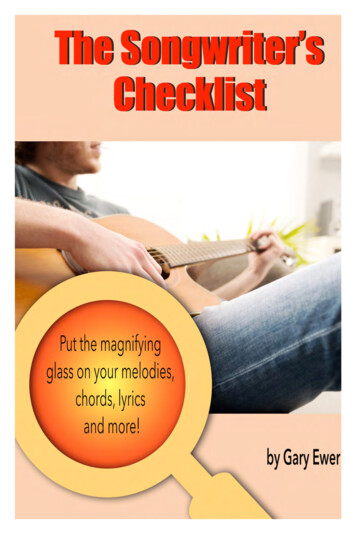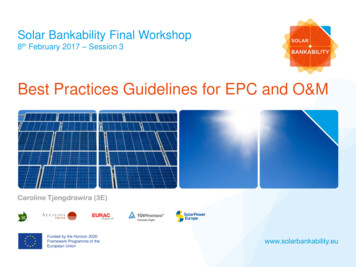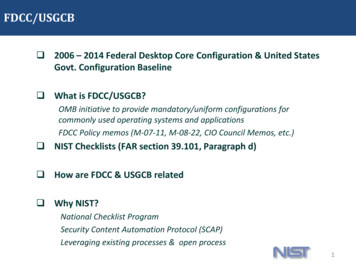
Transcription
The Songwriter’s Checklist, 3rd editionGary EwerCopyright 2012, 2014, 2016, 2018 by Pantomime Music Publications and Gary EwerAll rights reserved. This book is protected by Copyright. Permission must be obtained inwriting from Pantomime Music Publications for the use of any original text contained withinthis publication. Permission must be obtained from the publisher prior to any reproduction,storage in a retrieval system, or transmission in any form or by any means, electronic,mechanical, photocopying, recording, or likewise.Table of ContentsHOW TO USE THIS CELLANEOUS12
How to Use This ChecklistThe Songwriter’s Checklist is meant to help youwhen you feel that your songs are failing insome way. Don’t use it if your songs areworking. Why? Some songs work really welldespite perhaps violating conventional wisdom(e.g., they might have a chorus melody that’slower than the verse). In those cases, you mightinadvertently damage an otherwise great song.But if you’re feeling that the song you’re working on just seems to bemissing the mark, see which items on the Checklist are present, andwhich ones might be missing. Remember that songwriting is a processof creation that involves spontaneous assembling of ideas, andimprovisation. A checklist as a means for checking that kind of workmight seem counterintuitive, but in fact it allows you to slow down thecreative process and look at what you’ve written from a more objectivestandpoint.Here’s the best way to use the checklist:1. Make a simple recording of your latest song. Get it as closeto how you think it should sound as possible.2. Listen several times, and try to focus each time on yoursong’s various elements: melodies, chords, lyrics, rhythms, etc.3. Try to identify where you feel there are problems, even ifyou can’t identify what the problem is. Where is the spot (orspots) where you think weaknesses lie?4. Slowly go through the checklist. Don’t expect everything inthe checklist to be present in your song. That would be
unreasonable. But the majority of good songs do tend todemonstrate most of the items on this list.5. Make a determination as to which checklist items you thinkyou should apply to your song.I’ll say again that it’s important to remember that no song everwritten includes everything on the Checklist. So what you’relooking for is a majority of items, not all of them. The Songwriter’sChecklist is meant to focus your attention, and give you something tothink about.
To learn everything you need to know about good songwriting, check out:“The Essential Secrets of Songwriting” 10-eBook Deluxe BundleGet today’s special deal: a FREE copy of “Use Your Words! Developing aLyrics-First Songwriting Process”.The 10-eBook Bundle includes: The Essential Secrets of Songwriting, 4th edition Essential Chord Progressions, 2nd edition More Essential Chord Progressions, 2nd edition How to Harmonize a Melody Chord Progression Formulas The Essential Secrets of Songwriting 9-Lesson Course From Amateur to Ace: Writing Songs Like a Pro Fix Your Songwriting Problems - NOW Hooks and Riffs: How They Grab Attention, Make Songs Memorable, andBuild Your Fan Base Writing a Song From a Chord Progression PLUS a FREE COPY of "Use Your Words! Developing a Lyrics-FirstSongwriting ProcessVISIT THE ONLINE STORE
MELODY/RHYTHMTo read more about melody, rhythm and hooks, and how theycontribute to the strength of a song’s musical structure, readChapter 5 of “The Essential Secrets of Songwriting, 4th Edition”,and “Hooks and Riffs”! My melody shows good contour, with adistinctive shape.! I can identify a moment in the verse that wouldserve as a climactic point for that melody.! I can identify a moment in the chorus that wouldserve as a climactic point for the song.! The climactic moment in my chorus takesprecedence over the climactic moment of theverse.! Repetition serves as an important organizingfeature in my song, and is an important part ofmy song’s chorus hook.! My verse melody works its way upward, andconnects somewhat seamlessly to the chorus. (Ifit doesn’t, it uses a pre-chorus do make the
connection)! My chorus melody resides a bit higher than theverse melody, and features the tonic (key) notemore than in the verse.! My bridge brings in a third melody,accompanied by both diatonic and alteredchords, or explores the opposite mode (e.g.,major key songs move into the minor).! The rhythms of the verse melody are mainlyquicker and possibly more complex than thechorus rhythms.! Chorus rhythms tend to simplify.
CHORDS/HARMONYTo read more about chords and harmony, read Chapter 4 of “TheEssential Secrets of Songwriting, 4th Edition”, and read also: “Howto Harmonize a Melody”, “Chord Progression Formulas”, and“Writing a Song From a Chord Progression”! I use more tonally strong progressions in thechorus, with more interesting "fragile"progressions in the verse.! I use more vocal harmonies in the chorus than Ido in the verse.! I start the bridge, or any other "miscellaneous"section of my song on a chord other than thetonic chord.! The majority of progressions throughout thesong feel like a complete musical journey, andany complex progressions eventually feelresolved by progressions in the chorus.! Most of my song’s progressions target the tonicchord.
! There is a pleasant sense of predictability in mysong’s chord progressions, particularly in thechorus.! There is also a sense of predictability withregard to the frequency of chord changes,called the harmonic rhythm. (e.g., every bar, orevery two bars).! The chords support the notes of the melodiesat any given time.! I use inversions to either smooth out the bassline, or to add a sense of variety to the chordchoices.
LYRICSTo read more about lyrics, read Chapter 5 of “The EssentialSecrets of Songwriting, 4th Edition”, as well as “Use Your Words!Developing a Lyrics-First Songwriting Process”! I use relatively plain, everyday language thatconnects with average people.! Despite my use of plain language, I findopportunities to say or describe things, events,people, etc., with an occasionally clever turn ofphrase.! Imagery plays an important part in my lyrics.! I ensure that my verse lyrics primarily describeevents, people and situations, while my choruslyrics primarily describe reactions andemotions.! I try to find concise ways to say things, and avoidbeing unnecessarily wordy.! The song title, when sung, uses longer notevalues than other lyrics.
! I make good use of rhymes and close rhymes,being mindful not to allow rhyming to feelforced or artificial.! The natural pulse of my lyrics matches (at leastmost of the time) the natural pulse of mymelodies as determined by the time signature.
MISCELLANEOUSTo read more about the formal design of songs, inspiration, andcopyright issues, read “The Essential Secrets of Songwriting,” 4thed., Chapters 1-3, 6 and 7.! My song shows, even in a small degree,something innovative that sets it apart fromother songs I've written, and other songs of thesame genre that listeners would know.! My song gets to the chorus before the 1-minutemark.! My song is not needlessly long.! I've tried to incorporate something uniqueregarding instrumentation (fiddle, acousticguitar, acoustic orchestral instrument, etc.).! The song's intro is, even in just some smallmeasure, interesting, and is likely to pull alistener into the rest of the song.! I've varied the overall loudness of the song sothat the basic dynamic level shows aninteresting and compelling contour.
! This song differs in significant ways from the lastfew songs I’ve written.Practice makes perfect, but you may simply be reinforcing errors that you’vebeen making for years. If you can’t seem to take your songwriting to the nextlevel, I’m hoping that you may find my songwriting eBooks will be just whatyou need to get on the right path.I’d love for you to read more about those ten songwriting eBooks. They’vebeen helping thousands of songwriters take their technique to the next level.Right now, purchasing ““The Essential Secrets of Songwriting 10-eBookBundle” gives you a free copy of “Use Your Words – Developing a LyricsFirst Songwriting Process”. It’s an eBook that shows you how to make lyricwriting an important point of focus in your writing technique.All the best with your songwriting projects!-Gary EwerVISIT THE ONLINE STORE
progressions in the verse. ! I use more vocal harmonies in the chorus than I do in the verse. ! I start the bridge, or any other "miscellaneous" section of my song on a chord other than the tonic chord. ! The majority of progressions throughout the song feel like a complete musical journey, and any complex progressions eventually feel











